全文HTML
--> --> -->









怎样设计一个物理系统并控制它来实现量子逻辑门, 一直是人们关注的问题. 1995年, Monroe等[10]首次利用离子阱装置实现了两量子比特受控非门(controlled-NOT, CNOT)的演示实验, 证实了量子计算的可行性. 常见的实验系统还有超导回路[11]、核磁共振[12,13]、量子点[14]、冷原子[15]以及线性光学系统[16]等. 其中, 线性光学系统具有一些独特的优点: 光子传播速度非常快, 适于作为传输量子信息的载体; 利用线性光学元件很容易实现光子量子比特的高精度制备和操纵; 最重要的是, 光子量子比特相干时间很长[17], 它很难和其他光子发生相互作用, 但这也导致了光量子比特之间的控制门操作极难, 进而实现光量子计算似乎是不可能的. 2000年, Knill, Laflamme和Milburn 证明了仅使用线性光学元件、单光子源和单光子探测器就可以构建通用型量子计算机—这就是著名的KLM方案[18], 于是线性光学系统成为备受青睐的量子信息实验平台[19,20]. 目前的主要研究方向有两类: 一是在自由空间中操纵光子的线性光学量子计算, 它操作简单, 技术成熟, 目前绝大多数量子计算方案都是在自由空间光学系统中首先被验证的, 但其可扩展性差、稳定性差, 非常容易受到环境因素扰动; 二是基于集成芯片的光量子计算, 芯片中通常使用光波导来构建复杂的光子回路. 尽管波导芯片系统目前还是处于起步阶段, 但是具有良好的可扩展性、稳定性和高集成度, 因此前景广阔.
编码光子量子比特qubit的方式灵活而多样[21,22], 比如路径编码(path-encoding), 即光子传播时可能通过的两条路径分别代表|0




































2008年, Politi等[23]利用光刻方法在硅片上制备了二氧化硅波导量子回路, 成功实现了稳定的量子干涉, 首次演示了集成的线性光学CNOT门的功能, 该实验中的量子比特采用路径编码. 2009年, 英国布里斯托尔大学的O’Brien研究组和澳大利亚麦考瑞大学的Withford研究组联合首次采用飞秒激光直写技术制备出了二维波导光量子回路, 展示了基于集成光学器件实现的多光子量子干涉[24]. 飞秒激光直写波导的原理是Davis等[25]提出的, 通过高阶非线性吸收, 飞秒脉冲激光可以准确地将能量沉积在透明介质内部, 引起介质折射率的永久性改变, 这种无需掩模版的单步骤加工方式能够以极低的成本在介质体内部直接加工出完整的器件. 尤为重要的是, 飞秒激光直写技术可以突破光学微加工方法中由于衍射极限给加工精度带来的限制, 并能直接在透明材料内部加工出真正的三维微结构, 这是传统光刻技术所无法企及的. 此外, 它可以提供近圆形的波导截面形貌, 波导双折射低, 非常适于操控偏振编码的量子比特[26-29]. 许多飞秒激光加工的经典器件, 从简单的Y型分束器[30]到更复杂的多波导集成器件[31-33], 已经被广泛应用于通讯、集成生物传感等诸多领域[34-37]. 量子逻辑门[24]、量子随机行走[38-40]、量子玻色采样[6,7,41,42]和量子模拟[43,44]等大量重要的光量子信息操作器件也都是利用飞秒激光直写技术制备的.
本文介绍飞秒激光直写技术在加工光量子逻辑门方面的进展. 结构安排如下: 第2节综述飞秒激光直写波导定向耦合器方面的进展, 包括定向耦合器的功能、构成和性能表征, 并以我们加工的定向耦合器为例进行说明; 第3节综述飞秒激光直写单量子比特逻辑门的进展, 主要包括哈达玛(Hadamard, H)门、泡利交换(Pauli-X)门以及集成波片的加工; 第4节综述飞秒激光直写两量子比特逻辑门的进展, 主要包括受控相位(controlled-Z, CZ或controlled-PHASE)门和CNOT门以及我们加工的CNOT门的量子性能; 第5节是飞秒激光加工三量子比特逻辑门的展望; 第6节是本文的总结与展望.
 图 1 双光子HOM量子干涉示意图 (a)两个光子通过分束器后都透射和都反射的情况相干相消, 仅会出现一个光子透射而另一个光子反射的情况, 即光子成对的从分束器的任意一个输出端口离开; (b)在分束器两个输出端口对两个输出光子的符合计数值随两个光子进入分束器时的相对延时的变化曲线
图 1 双光子HOM量子干涉示意图 (a)两个光子通过分束器后都透射和都反射的情况相干相消, 仅会出现一个光子透射而另一个光子反射的情况, 即光子成对的从分束器的任意一个输出端口离开; (b)在分束器两个输出端口对两个输出光子的符合计数值随两个光子进入分束器时的相对延时的变化曲线Figure1. Two-photon HOM quantum interference in a balanced beam splitter. (a) Destructive interference of two situations: both photons are transmitted and reflected. Only one photon is transmitted and the other photon is reflected. Photons leave in pairs from any of the beam splitter's output ports. (b) The coincidence counts of detecting a photon at each output of the splitter as a function of the relative delay of the photons.
对于一个50 : 50的分束器, 当两个不可分辨的全同光子(频率、偏振、空间模式等都相同)同时从两个输入端口入射, 假定输入光子的模式是a和b, 输出光子的模式是c和d, 光子在分束器上发生反射后获得


那么, 如何用集成波导实现类似于分束器的功能呢?O’Brien研究组的实验采用的是定向耦合器(directional coupler, DC)[24], 当两个波导的空间间隔足够近时两个波导的倏逝场重叠就可以实现干涉, 如图2所示. 通过精确调节定向耦合器耦合区两个波导之间的间距d和相互作用长度L, 可以对耦合效率1–R (R相当于分束器的反射率)也即对分束比进行调节.
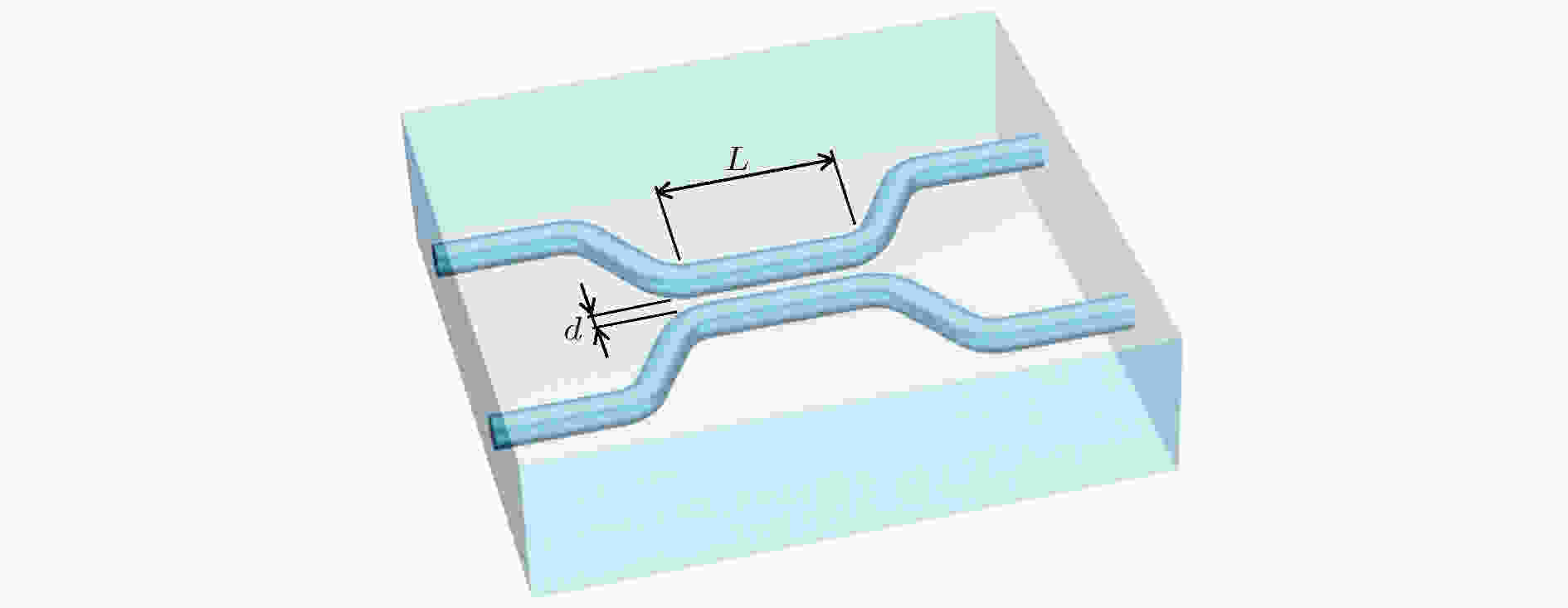 图 2 基于波导的2 × 2集成定向耦合器示意图, 其中, d和L分别表示耦合区两个波导之间的间距和相互作用长度
图 2 基于波导的2 × 2集成定向耦合器示意图, 其中, d和L分别表示耦合区两个波导之间的间距和相互作用长度Figure2. Schematic of anintegrated DC consisting of two waveguides. Interaction distance and length in the coupling region are denoted by d and L, respectively.
2009年, 高干涉可见度的单光子、双光子及多光子量子干涉现象首次在激光直写的集成光波导芯片中得到展示[24], 如图3所示. 采用飞秒激光直接在熔融石英玻璃中写入的定向耦合器(R = 0.5128 ± 0.0007)的HOM干涉可见度为0.958 ± 0.005.
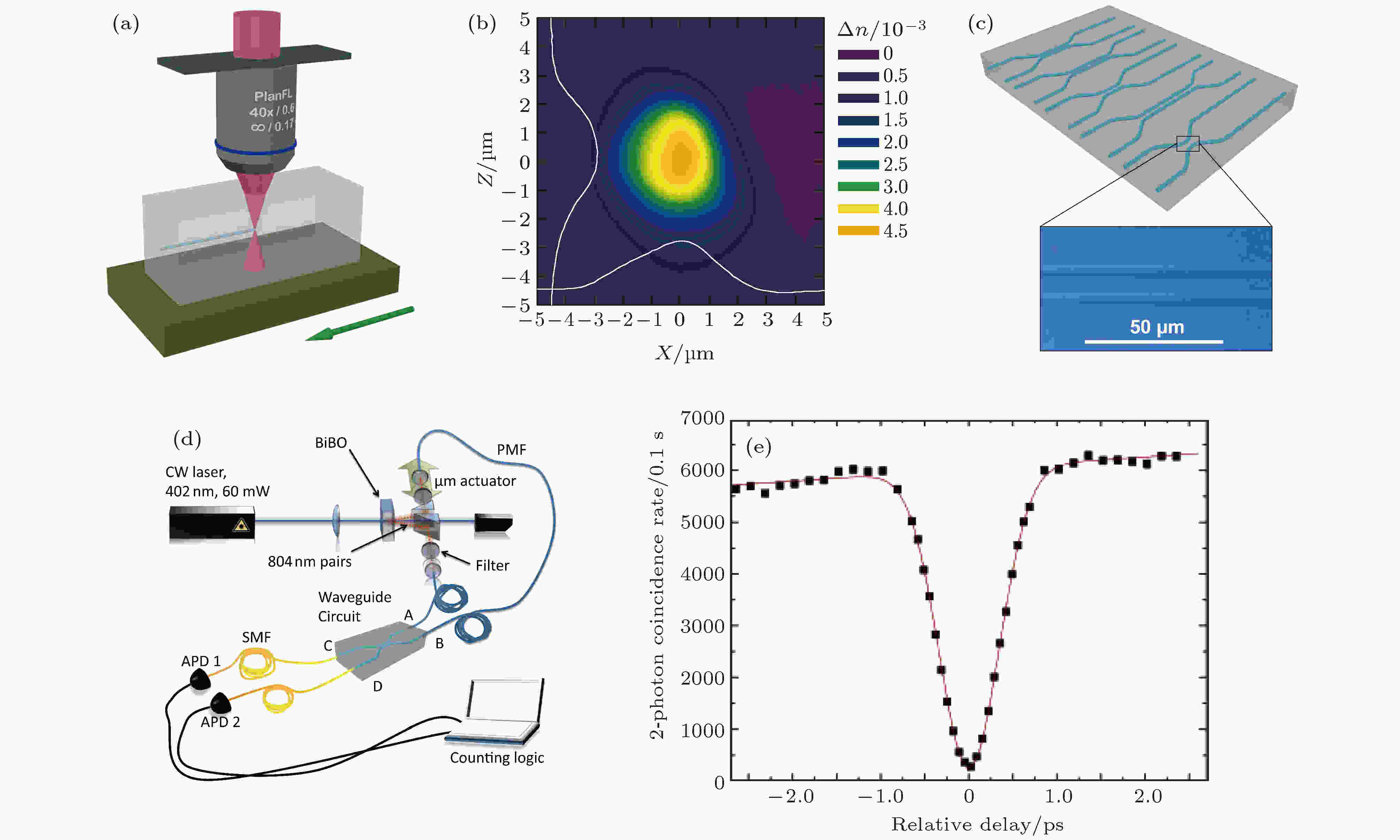 图 3 飞秒激光直写定向耦合器示意图和测得的HOM干涉曲线[24] (a)飞秒激光横向直写波导示意图; (b)飞秒激光在波导截面引起的折射率变化; (c)飞秒激光直写的定向耦合器阵列; (d)量子光源表征定向耦合器的实验装置; (e)双光子符合计数随光子间相对延迟差的变化曲线
图 3 飞秒激光直写定向耦合器示意图和测得的HOM干涉曲线[24] (a)飞秒激光横向直写波导示意图; (b)飞秒激光在波导截面引起的折射率变化; (c)飞秒激光直写的定向耦合器阵列; (d)量子光源表征定向耦合器的实验装置; (e)双光子符合计数随光子间相对延迟差的变化曲线Figure3. Schematic of femtosecond laser direct writing of DCs based on waveguides and the coincident counts of detecting a photon at each output of the coupler as a function of the relative delay in arrival time of the photons[24]; (a) Femtosecond laser transverse writing of waveguides; (b) femtosecond laser induced refractive index change at the cross section of the waveguide; (c) femtosecond laser written DC array; (d) experimental setup for quantum characterization of DCs; (e) the coincident counts of detecting a photon at each output of the coupler as a function of the relative delay in arrival time of the photons.
2015年, Chaboyer等[47]利用飞秒激光独特的三维加工优势在玻璃内部制备了由两个可调谐三端口分束器串联组成的多路径类马赫-曾德尔干涉仪(Mach-Zehnder interferometer, MZI)芯片, 如图4(a)所示, 分束器的中间一臂相较其他两臂特地抬升了127 μm以接近芯片表面的热光相移器. 通过改变加载在相移器上的电压来调节该臂上产生的相移量θ, 从而调谐双光子干涉的可见度, 如图4(b)所示. 三维加工时较大的深度变化可能会对波导形貌和折射率分布产生一定影响, 可以通过在空间光调制器上加载针对球差等对深度变化敏感的像差的矫正相位板来进行实时的矫正调节.
 图 4 可调谐三端口干涉仪(a)和不同相移量θ值下, 干涉仪输出端口两光子符合计数值随两光子进入干涉仪时的相对延迟差的变化曲线(b)[47]
图 4 可调谐三端口干涉仪(a)和不同相移量θ值下, 干涉仪输出端口两光子符合计数值随两光子进入干涉仪时的相对延迟差的变化曲线(b)[47]Figure4. Schematic ofa tunable 3D multi-path interferometer (a) and the coincident countsof detecting photons at outputs of the interferometer under different phase shift θ as a function of the relative delay in arrival time of the photons (b)[47]. Copyright: http://creativecommons.org/licenses/by/4.0/ for CC BY.
波导双折射的大小会直接影响定向耦合器的偏振特性, 比如光子经过不同的输入-输出路径时将会获得不同的偏振变换, 而且输入偏振态不同也会导致不同的分束比. 那么, 如何制备出偏振不敏感的定向耦合器(polarization insensitive coupler, PIC)呢? 主要有两种方法[48]: 一是双折射补偿法, 如图5所示, 第二根波导的写入会影响第一根波导的双折射以及两种偏振的耦合系数kH和kV[49,50], 而两根波导的双折射不相同就会导致前述的路径依赖的偏振变换, 解决方法是在耦合区域内第二根波导旁边加写一根额外的损伤轨迹, 使其对第二根波导双折射的影响等同于第二根波导对第一根的影响; 二是退火法, Arriola等[51]证明了对硼硅玻璃中写入的多模波导进行退火处理可以减小导光区域、增强芯和包层的折射率对比, 从而得到低损耗的单模波导, 此外, 这种方法还可以有效降低双折射, 减小分束比的偏振依赖程度, 有利于制备偏振无关的光量子集成回路.
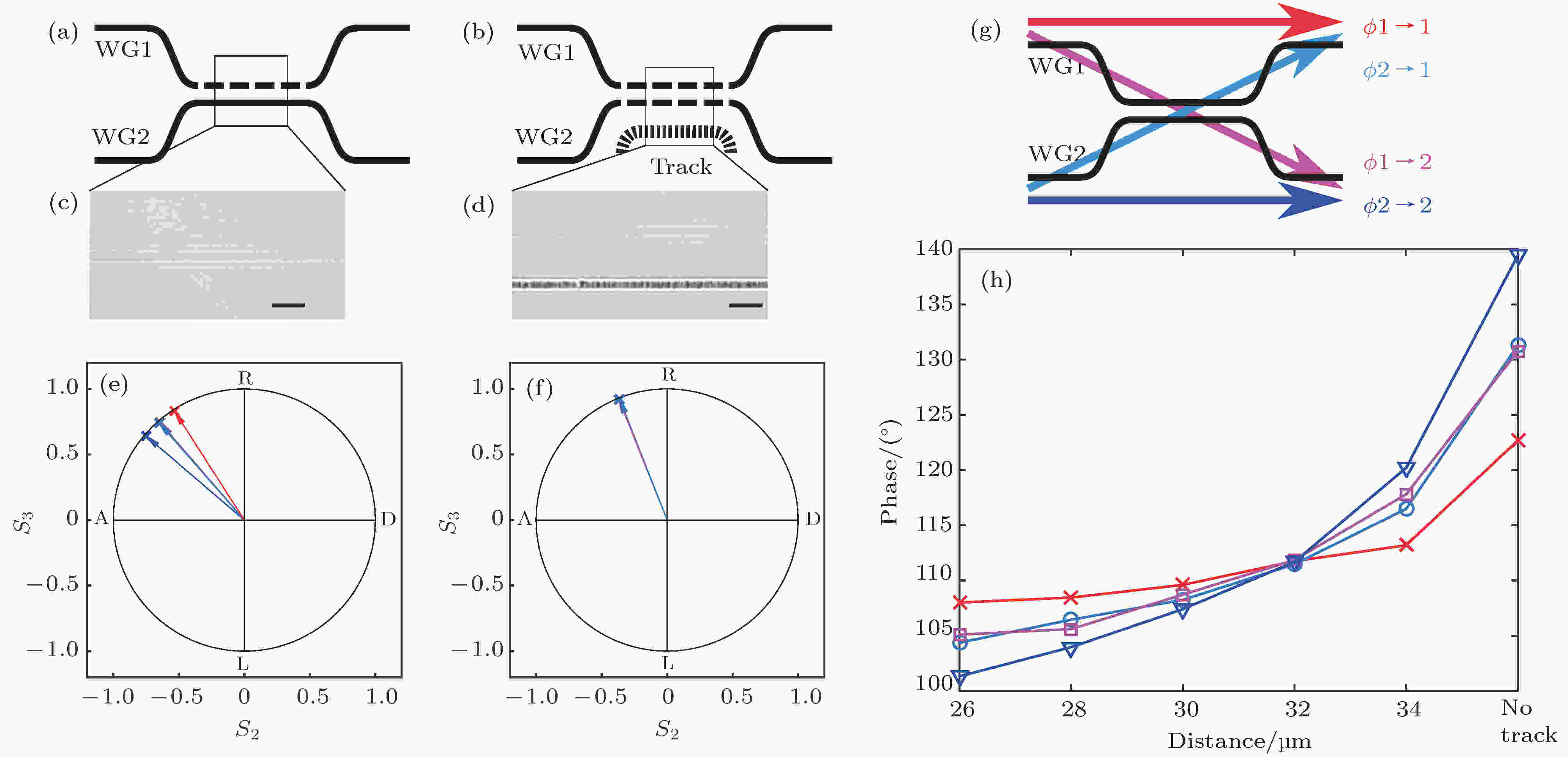 图 5 双折射补偿法制备偏振不敏感的定向耦合器[48] (a)飞秒激光直写定向耦合器示意图, 第二根写入的波导的双折射会受到第一根写入的波导的影响; (b)利用不同的加工参数在第二根波导旁边写入一根损伤线, 可以平衡两根波导的双折射; (c), (d)定向耦合器耦合区域分别在加写损伤线之前和之后的显微镜图, 损伤线距离第二根波导32 μm, 图中标尺为20 μm; (e), (f)对角线偏振光入射时, 定向耦合器输出态分别在加写损伤线之前和之后的斯托克斯分量; (g)光从m波导入射, 从n波导出射时, 在水平偏振和垂直偏振分量之间获得了相移φm→n; (h)相移φm→n随损伤线距离的变化曲线, 当距离为32 μm时, 四种情况下的φm→n一致
图 5 双折射补偿法制备偏振不敏感的定向耦合器[48] (a)飞秒激光直写定向耦合器示意图, 第二根写入的波导的双折射会受到第一根写入的波导的影响; (b)利用不同的加工参数在第二根波导旁边写入一根损伤线, 可以平衡两根波导的双折射; (c), (d)定向耦合器耦合区域分别在加写损伤线之前和之后的显微镜图, 损伤线距离第二根波导32 μm, 图中标尺为20 μm; (e), (f)对角线偏振光入射时, 定向耦合器输出态分别在加写损伤线之前和之后的斯托克斯分量; (g)光从m波导入射, 从n波导出射时, 在水平偏振和垂直偏振分量之间获得了相移φm→n; (h)相移φm→n随损伤线距离的变化曲线, 当距离为32 μm时, 四种情况下的φm→n一致Figure5. Polarization-independent DC based on local birefringence engineering[48]: (a) Schematic of a femtosecond written DC, the birefringence of the second waveguide is modified by the previously inscribed first one; (b) an additional damage track, with tuned irradiation parameters, is inscribed next to the second waveguide, leading to birefringence equalization; (c), (d) microscope images of the interaction region of the DCs without and with the inscription of the additional track at a distance of 32 μm, scale bar is 20 μm; (e), (f) Stokes parameters of the output states for couplers without and with the additional track, for diagonally polarized input light and various input-output combinations. A planar projection of the Poincaré sphere is represented; (g) light that enters in waveguide m and exits from waveguide n acquires a phase shift φm→n between the horizontally and the vertically polarized components; (h) the different values of φm→n are plotted as a function of distance of the track from the second waveguide. For a distance of 32 μm, the four possible φm→n coincide.
我们课题组利用飞秒激光加工的基于波导的50 : 50分束的2 × 2定向耦合器的HOM干涉可见度达到约0.98. 实验装置如图6所示, 激光器(PHAROS, Light Conversation)的中心波长约1030 nm, 重复频率约1 MHz, 脉宽约为240 fs. 光束经过凹透镜L1(焦距f1 = -50 mm)和凸透镜L2(焦距f2 = 75 mm)扩束后进入物镜(20 × NA 0.5, Olympus)聚焦于一块20 mm × 25 mm × 1 mm的EAGLE2000玻璃(Corning)内部, 聚焦深度约为170 μm. 样品固定在三维气浮移动台上(ABL1000, Aerotech).
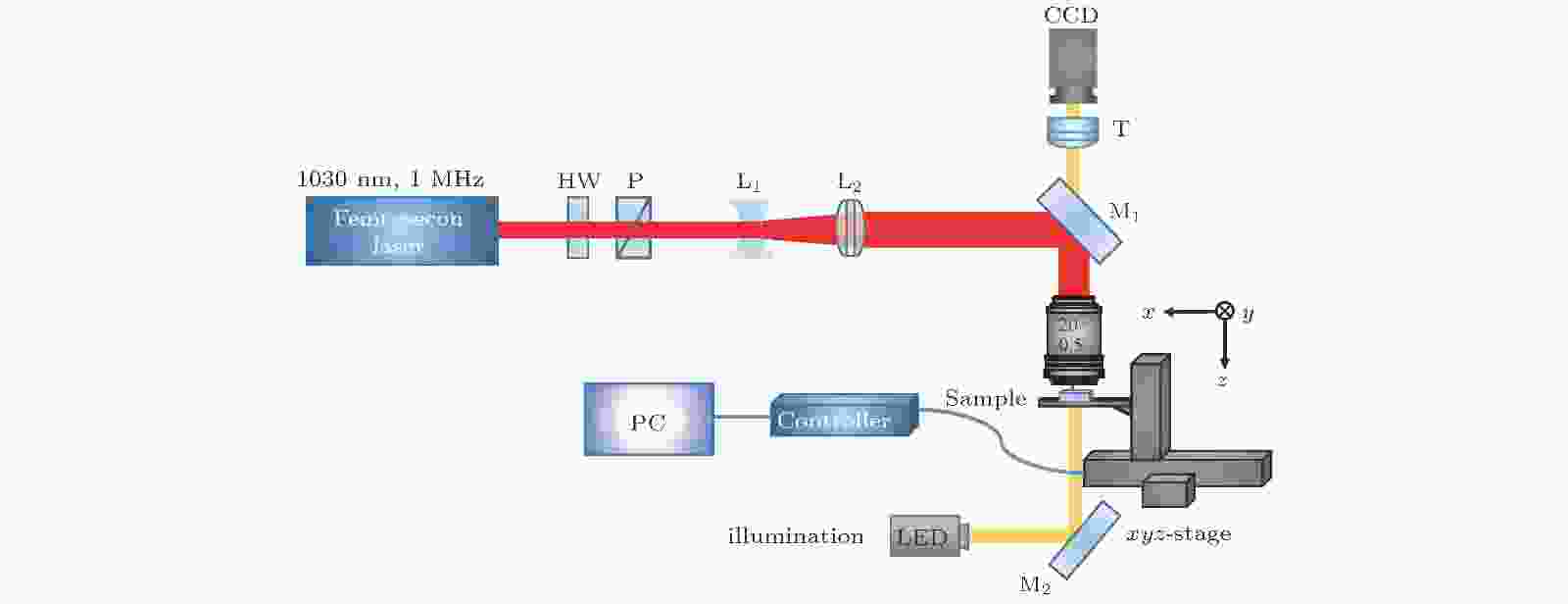 图 6 飞秒激光加工光量子逻辑门实验装置图
图 6 飞秒激光加工光量子逻辑门实验装置图Figure6. Experimental setup for femtosecond laser fabrication of photonic quantum logic gates.
我们首先优化单脉冲能量、扫描速度等参数以加工出在约808 nm波长处导模为单模且损耗最低的直波导. 测试波导性能时, 我们通过单模光纤将波长808 nm的连续激光导入长度约为2.5 cm的直波导中, 用物镜收集波导输出的光场, 而后用电荷耦合器(charge coupled device, CCD)拍摄导光模式. 波导的总插入损耗主要包括传播损耗、耦合损耗和菲涅尔损耗[52]. 测量波导输入和输出的功率P1和P2, 根据–10log10(P2/P1)计算插入损耗, 利用模式重叠积分法[53]可以得到激光由光纤进入波导时的耦合损耗, 传播损耗通过截断法[54]得到. 通过比较导光模式和损耗, 确定的最佳加工参数为: 单脉冲能量296 nJ, 扫描速度40 mm/s, 在该参数下加工出的的波导截面形貌如图7(a)所示, 最中心较亮的导光区域形状较圆, 但是周围还分布着其他不导光区域, 这些可以通过狭缝法[55]或退火法[56]来改善. 如图7(b)所示, 导模是单模, 1/e2强度处模场大小为14.0 μm × 16.4 μm, 数值与808 nm单模光纤的模场直径(~5.5 μm)相差较大, 导致了较大的耦合损耗, 约为 1.9 dB/facet, 测得的插入损耗和传播损耗分别约为4 dB和0.7 dB/cm, 菲涅耳损耗约为0.2 dB/facet. 以后可以通过激光焦场整形和加入损伤线等方法[57]压缩导光模式使其与单模光纤模式尺寸匹配, 以减小耦合损耗从而减小插入损耗.
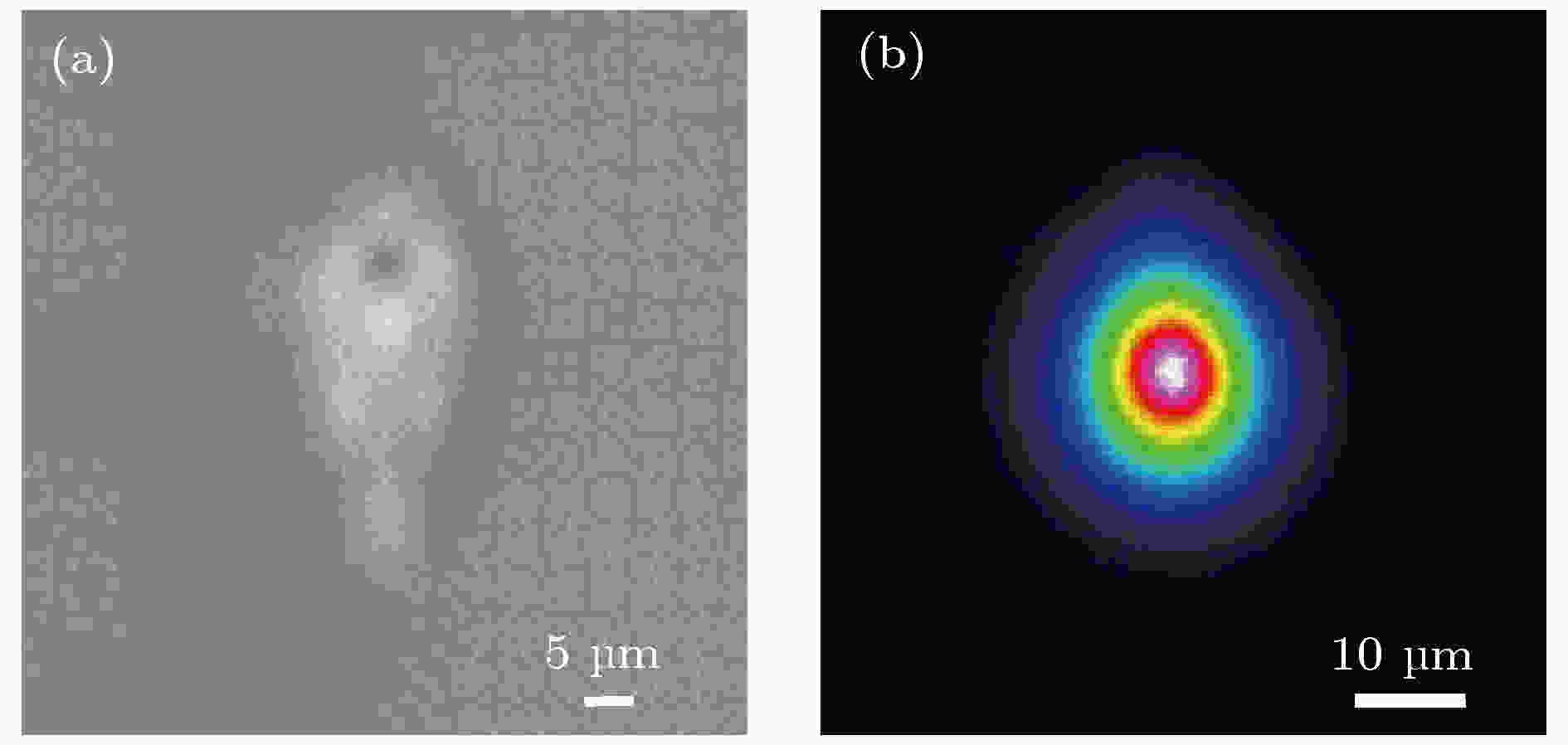 图 7 波导截面形貌显微图(a)和在808 nm波长处的导光模式(b)
图 7 波导截面形貌显微图(a)和在808 nm波长处的导光模式(b)Figure7. Microscope image of the cross section of the waveguide (a) and the near field image of the waveguide guided mode at 808 nm (b).
我们在此基础上加工了2 × 2定向耦合器. 对于定向耦合器中的弯曲部分, 我们发现当转弯半径> 30 mm时, 弯曲波导额外引入的弯曲损耗基本可以忽略[29], 最终我们将转弯半径设置为60 mm. 通过调控耦合区双波导的间距d和相互作用长度L, 可以得到不同的分束比. 实验中采用参数L = 130 μm, d = 8 μm加工出了R = 0.4930 ± 0.0007的耦合器, 当光从另一臂端口入射时R = 0.5010 ± 0.0007, 具有高度的对称性, 满足HOM量子干涉实验的测量要求.
定向耦合器在808 nm波长的导模如图8(a)所示, 两个导模强度均匀、对称. 我们通过中心波长约为404 nm的连续激光器(ECL801, UniQuanta)泵浦两块光轴相互垂直粘合而成的I型相位匹配BBO晶体, 自发参量下转换(spontaneous parametric down conversion, SPDC)产生808 nm波段偏振纠缠的全同单光子对, 它们的偏振要么都是垂直的, 要么都是水平的, 各有50%概率. 用两根长度一致的单模光纤分别收集两路单光子, 其中一路光纤上装有由步进电机控制的延迟线, 以便调节两路光子到达样品的相对时间, 再把两根光纤连接到一组间距为127 μm的单模光纤阵列上以将单光子输入到芯片中, 芯片输出的单光子由光纤阵列收集后通过单光子探测器(Excelitas, SPCM-850-14-FC)探测,而后送入多通道时间数字转换器(ID800, IDQ)进行符合计数测量, 实验装置类似于图3(d). 实验中通过半波片附加四分之一波片精细调控每路光子的偏振态以获得较高的量子干涉可见度. 由图8(b)所示的两路单光子符合计数随着两条路径相对延迟差的变化曲线计算得到的干涉可见度达到约 0.98.
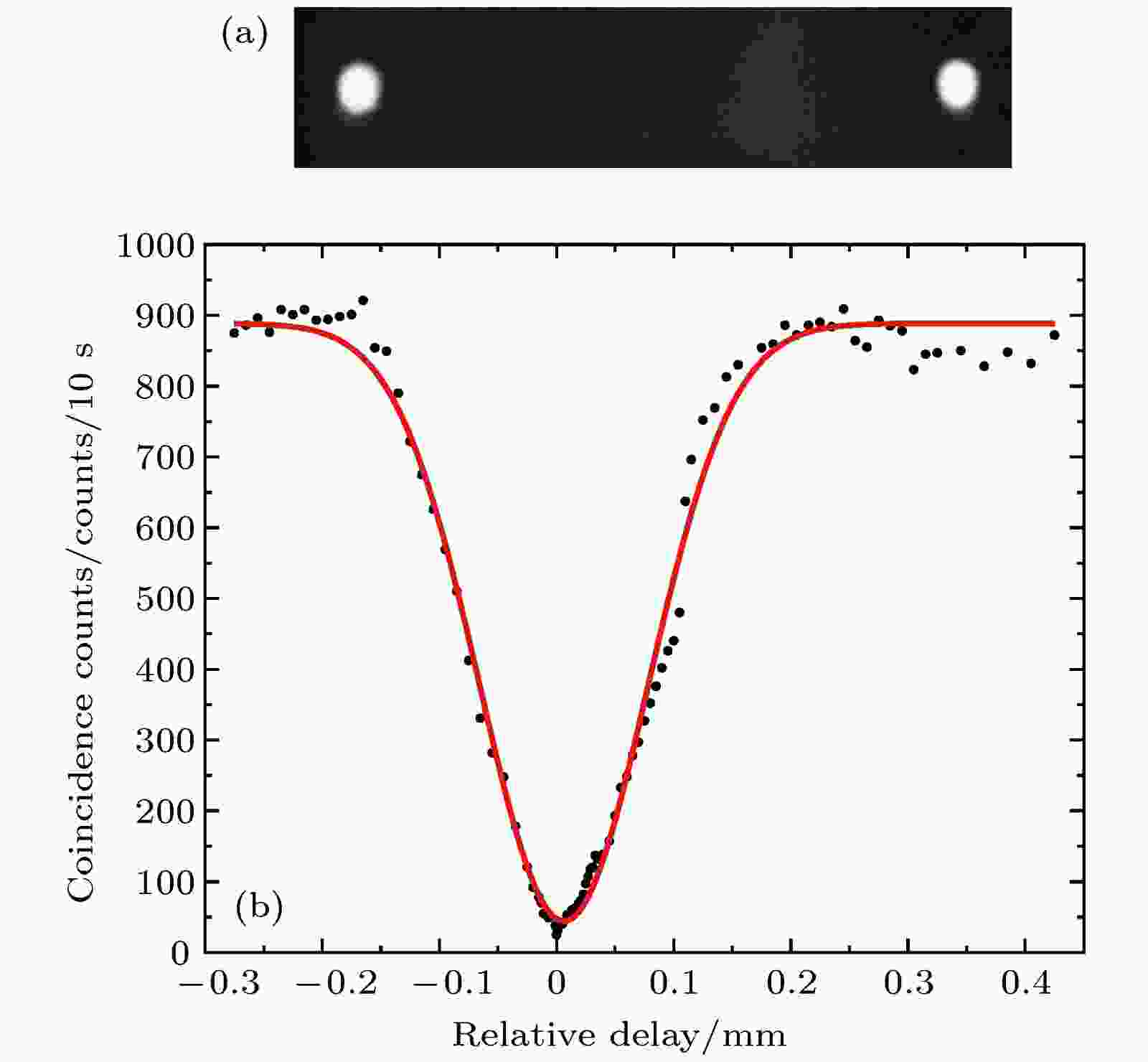 图 8 50 : 50分束比定向耦合器在808 nm波长处的导光模式(a)和测得的HOM干涉曲线(b), 干涉可见度约为 0.98
图 8 50 : 50分束比定向耦合器在808 nm波长处的导光模式(a)和测得的HOM干涉曲线(b), 干涉可见度约为 0.98Figure8. The near field image of the DC guided mode at 808 nm (a) and the coincidence counts of detecting photons at outputs of the DC as a function of the relative delay the photons(b), the visibility is ~ 0.98.








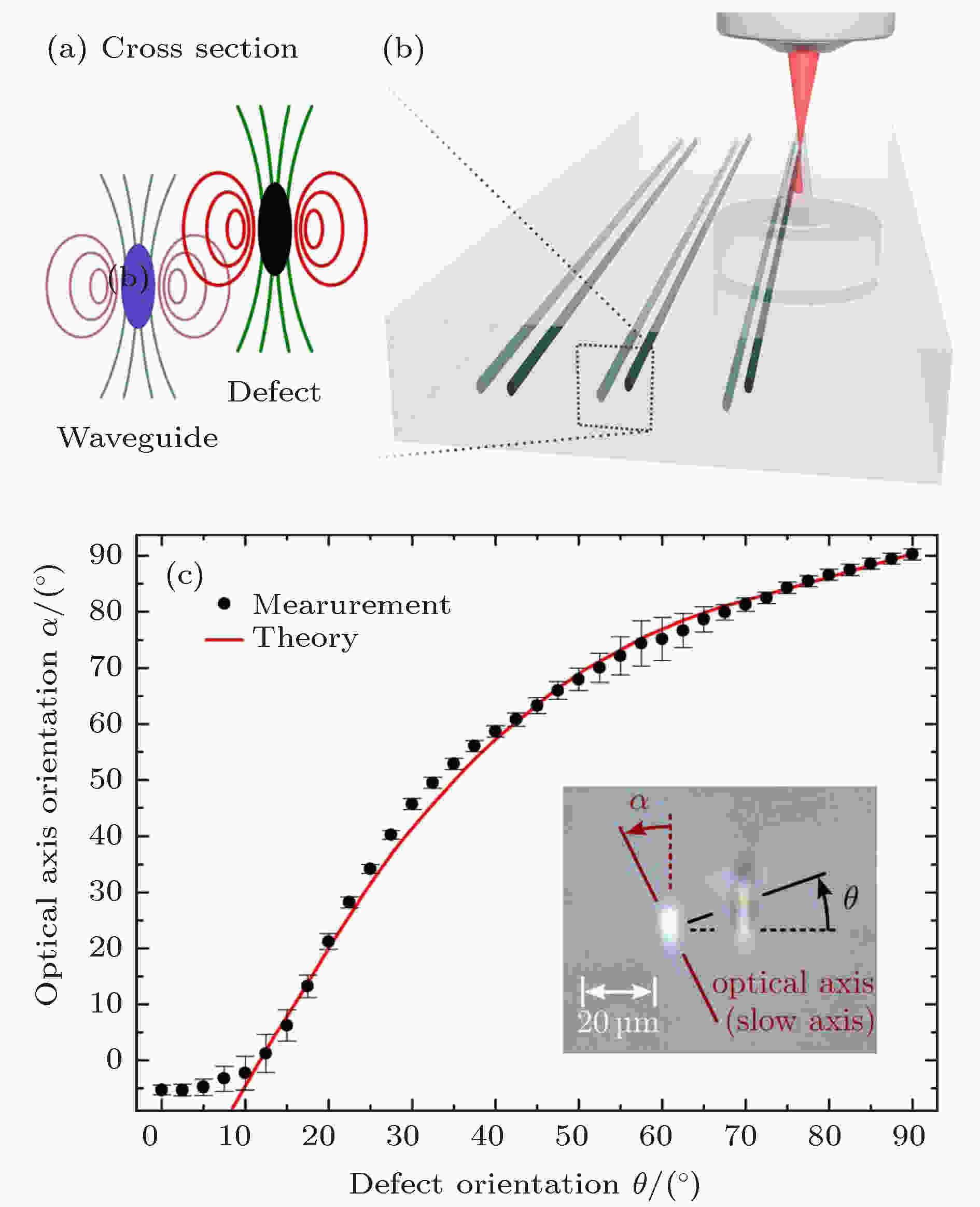 图 9 压力场调控波导双折射来获得特定的波片操作[58] (a)波导旁边附加写入的破坏线通过压力场改变波导光轴的取向; (b)飞秒激光直写三组不同相对位置破坏线示意图; (c)为波导光轴取向角α随破坏线相对位置取向角θ的变化曲线
图 9 压力场调控波导双折射来获得特定的波片操作[58] (a)波导旁边附加写入的破坏线通过压力场改变波导光轴的取向; (b)飞秒激光直写三组不同相对位置破坏线示意图; (c)为波导光轴取向角α随破坏线相对位置取向角θ的变化曲线Figure9. Settings of reorientation of the optical axis through stress fields and measured wave plate operations[58]: (a) Schematic of the cross section of the waveguide arrangement where additional stress fields induce a reorientation of the waveguide’s optical axis; (b) sketch of the writing setting, with which the quantum gates are fabricated (here for 3 different orientations of the defect relatively to the waveguide); (c) experimental data and best fit model of the reorientation of the optical axis α as a function of the azimuthal position of the defect θ. Copyright: http://creativecommons.org/licenses/by/4.0/ for CC BY.
另外一种任意调控波导光轴取向的巧妙方法是控制激光传播方向, 使其不再像绝大多数实验中垂直于样品表面, 而是倾斜一个角度θ, 波导光轴也相应旋转了同样的角度[60], 如图10所示. 具体来说, 采用高数值孔径油浸物镜(NA = 1.4), 让激光偏离物镜中心入射, θ的大小就取决于偏离量, 当θ = 22.5°时即实现偏振编码量子比特的H门操作.
 图 10 直写光倾斜入射调控波导光轴方向示意图[60] (a)直写激光正入射充满低数值孔径物镜, 产生的双折射波导光轴OA沿激光传播方向分布; (b)直写激光正入射未充满高数值孔径物镜可以带来和图(a)相同的效果; (c)直写激光偏移距离d后入射高数值孔径物镜使得激光在样品体内旋转θ角度, 波导光轴也随之旋转相同角度, θ取决于d; (d)通过在物镜前L距离处放置长焦透镜可实现直写激光的偏移和缩束
图 10 直写光倾斜入射调控波导光轴方向示意图[60] (a)直写激光正入射充满低数值孔径物镜, 产生的双折射波导光轴OA沿激光传播方向分布; (b)直写激光正入射未充满高数值孔径物镜可以带来和图(a)相同的效果; (c)直写激光偏移距离d后入射高数值孔径物镜使得激光在样品体内旋转θ角度, 波导光轴也随之旋转相同角度, θ取决于d; (d)通过在物镜前L距离处放置长焦透镜可实现直写激光的偏移和缩束Figure10. Conceptual scheme of the method enabling the direct writing of optical waveguides acting as integrated wave plates with tilted axis[60]: (a) Traditional writing scheme adopting a focusing objective with moderate NA; the symmetry of the writing layout creates birefringent waveguides with the optical axis (OA) aligned as the writing beam direction; actual waveguide writing is performed by a transverse translation of the glass sample (indicated by the purple arrow); (b) equivalent waveguides can be created by underfilling a high-NA oil-immersion objective; (c) offsetting the writing beam before the objective results in waveguide writing with an inclined laser beam; the resulting waveguide has an optical axis tilted by an angle θ that depends on the amount of offset d of the writing beam with respect to the objective axis; (d) reduced beam size and offset at the objective aperture is achieved by a small transverse shift of a long focal lens placed at a distance L from the focusing objective.
可以看出, 以上实现偏振编码H门的关键是对双折射光轴的灵活操作, 而路径编码H门的实现则相对简单. Politi等[61]在光子芯片上演示Shor算法时用到了路径编码的H门, 它实际上就是一个50 : 50分束比的定向耦合器, 如图11所示, 单量子态




 图 11 路径编码量子比特的H门
图 11 路径编码量子比特的H门Figure11. Schematic of a path-encoded qubit H gate.


















































如何利用集成波导实现CNOT门呢?首先是路径编码的CNOT门, 如图12所示, 控制比特C和目标比特T分别由两条波导路径来编码, 如果控制比特和目标比特的输出端口同时探测到了信号(概率为1/9), 则表示CNOT门操作成功. 该波导是完全根据Ralph等[62]以及Hofmann 和Takeuchi[63]在2002年提出的线性光学CNOT门方案来进行设计的, 整个波导芯片包含两个反射率R = 1/2和三个反射率R = 1/3的定向耦合器. 2003年, O’Brien等[64]首先利用体光学元件在自由空间中实现了这种路径编码的CNOT门, 但其可扩展性和稳定性差, 集成度低. 2008年, 他们在硅基二氧化硅片上利用传统光刻法制备了由定向耦合器集成的CNOT门芯片[23]. 目前还没有利用飞秒激光直写路径编码量子比特CNOT门的报道.
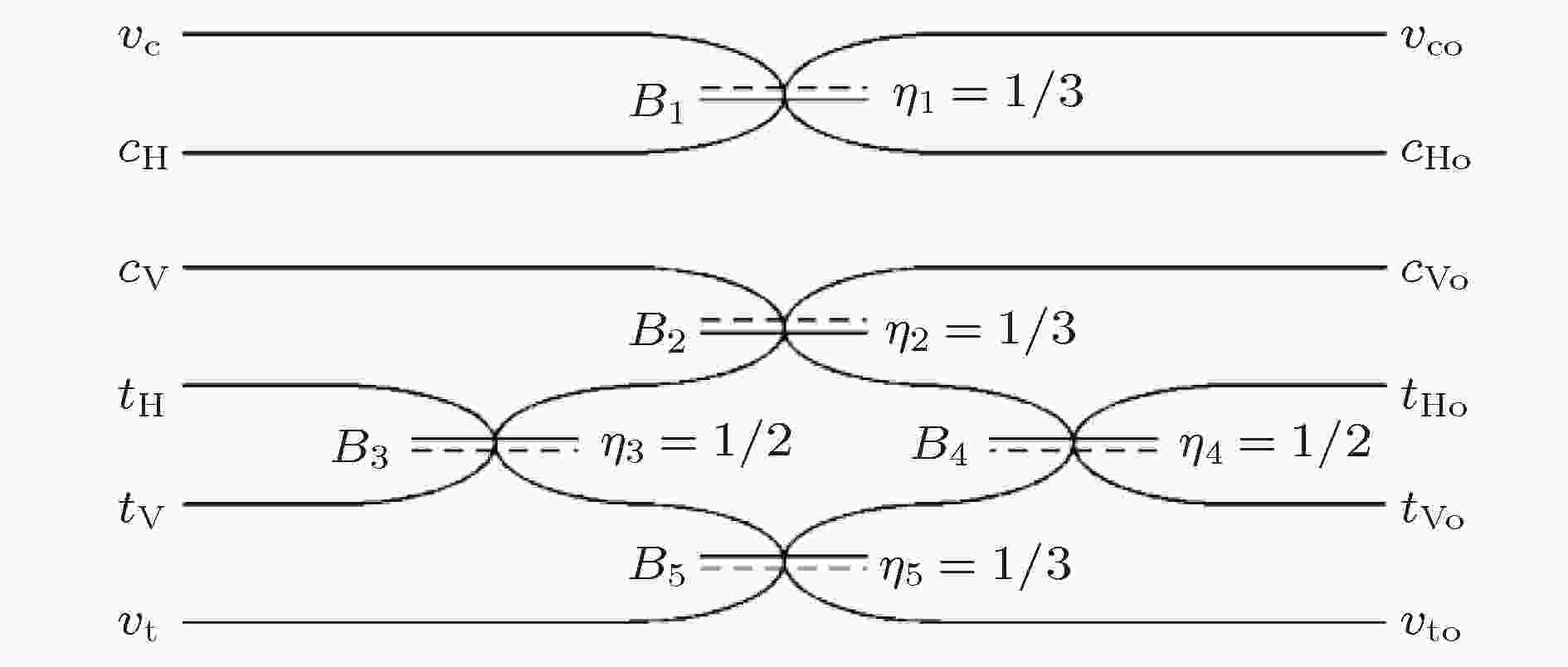 图 12 路径编码量子比特的CNOT门结构图[62] 虚线表示定向耦合器中附加相位
图 12 路径编码量子比特的CNOT门结构图[62] 虚线表示定向耦合器中附加相位
Figure12. Schematic of a path-encoded qubit CNOT gate based on waveguides[62]. Dashed line indicates the surface from which a sign change occurs upon reflection in a DC. The control modes are cH and cV. The target modes are tH and tV. The modes vc and vt are unoccupied ancillary modes. The numbers indicate the reflectivity of the corresponding directional coupler.
2011年, Crespi等[29]首次利用飞秒激光加工出了偏振编码的CNOT门, 并进行了完整的量子表征. 当光能量从一根波导传播到另一根波导时, 耦合器透射率随相互作用长度的变化遵循正弦规律, 振荡周期取决于两根波导中导模的耦合系数[65], 如果波导有双折射, 则H偏振态和V偏振态的耦合系数不一样, 所以它们的振荡周期也不同, 如图13(a)所示, 这种对不同偏振光具有不同分束比的定向耦合器又叫做部分偏振定向耦合器(partially polarizing directional coupler, PPDC). 整个CNOT门包含三个PPDC, 如图13(b)所示, 最关键的作用是PPDC1上目标比特和控制比特的HOM干涉, 它对于H偏振光和V偏振光的透射率分别是TH = 0,TV = 2/3, PPDC2和PPDC3起补偿作用, 它们的透射率相同, 为TH = 1/3, TV = 1, CNOT门操作成功的概率是1/9.
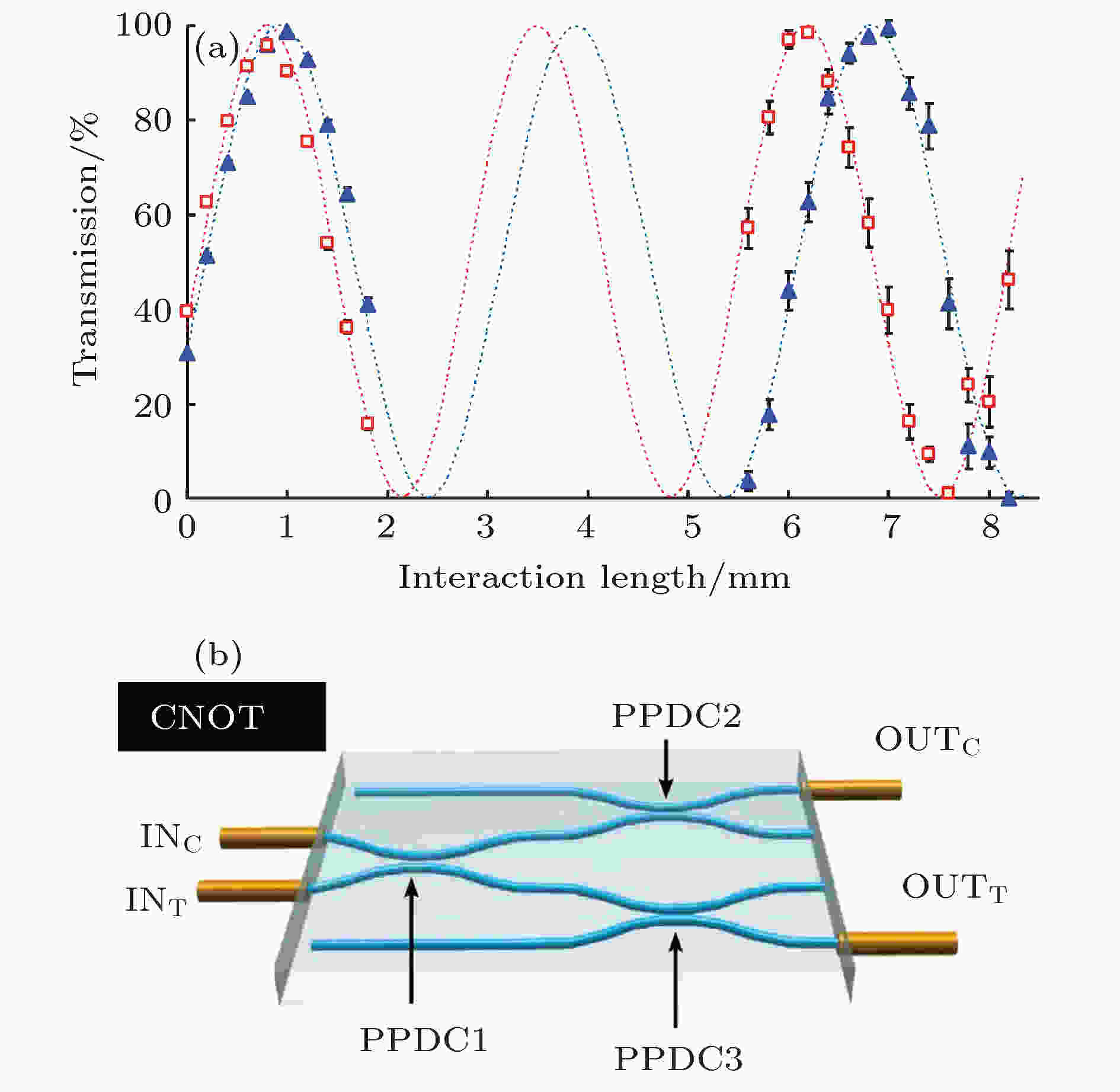 图 13 部分偏振定向耦合器中两种偏振态的耦合区能量交换振荡曲线(方块代表H态, 三角代表V态)(a)和偏振编码量子比特的CNOT门波导结构图(b)[29]
图 13 部分偏振定向耦合器中两种偏振态的耦合区能量交换振荡曲线(方块代表H态, 三角代表V态)(a)和偏振编码量子比特的CNOT门波导结构图(b)[29]Figure13. H (squares) and V (triangles) polarization transmissions of DCs with different interaction lengths, based on slightly birefringent waveguides (a) and schematic of a polarization-encoded qubit CNOT gate based on PPDCs (b)[29].
前面所述的CNOT门都是直接测量输出的控制比特和目标比特来检验门操作的成功与否, 称为非预报式CNOT门, 被测量的量子比特态受到破坏, 将不能继续作为后续量子回路的输入量子比特, 不利于发展大规模集成量子计算网络. 为了解决这个问题, 可预报式CNOT门应运而生, 即通过引入两个辅助光子来间接测量表征CNOT门操作, 当同时探测到两个输出的辅助光子时表明门操作成功, 避免了直接测量控制比特和目标比特, 使得它们可以接着被应用于后续的量子网络中, 有利于实现复杂量子计算的模块化. 2001年, Pittman等[66]提出了一种由两个偏振分束器(polarization beam splitter, PBS)构成的偏振编码可预报式CNOT门简化方案, 最大的亮点是入射的两个辅助光子不再是独立的, 而是被制备在最大贝尔偏振纠缠态

 图 14 纠缠态辅助光子的偏振编码可预报式CNOT门结构图(a)和量子性能表征实验装置示意图(b)[67]
图 14 纠缠态辅助光子的偏振编码可预报式CNOT门结构图(a)和量子性能表征实验装置示意图(b)[67]Figure14. (a) Scheme of a heralded photonic CNOT gate using a maximally entangled ancilla state with improved success probability 1/4. Detection of one photon in each of the modes


2002年, Knill[68]提出了一种最简单的路径编码量子比特的可预报式CZ门(hCZ门), 具有目前已知最高的成功概率, 为2/27. 如图15(a)所示, 这种hCZ门由四个定向耦合器组成, 四个不可区分的光子在其上成对地发生量子干涉, 并且第一对和第二对分束器之间有大小为























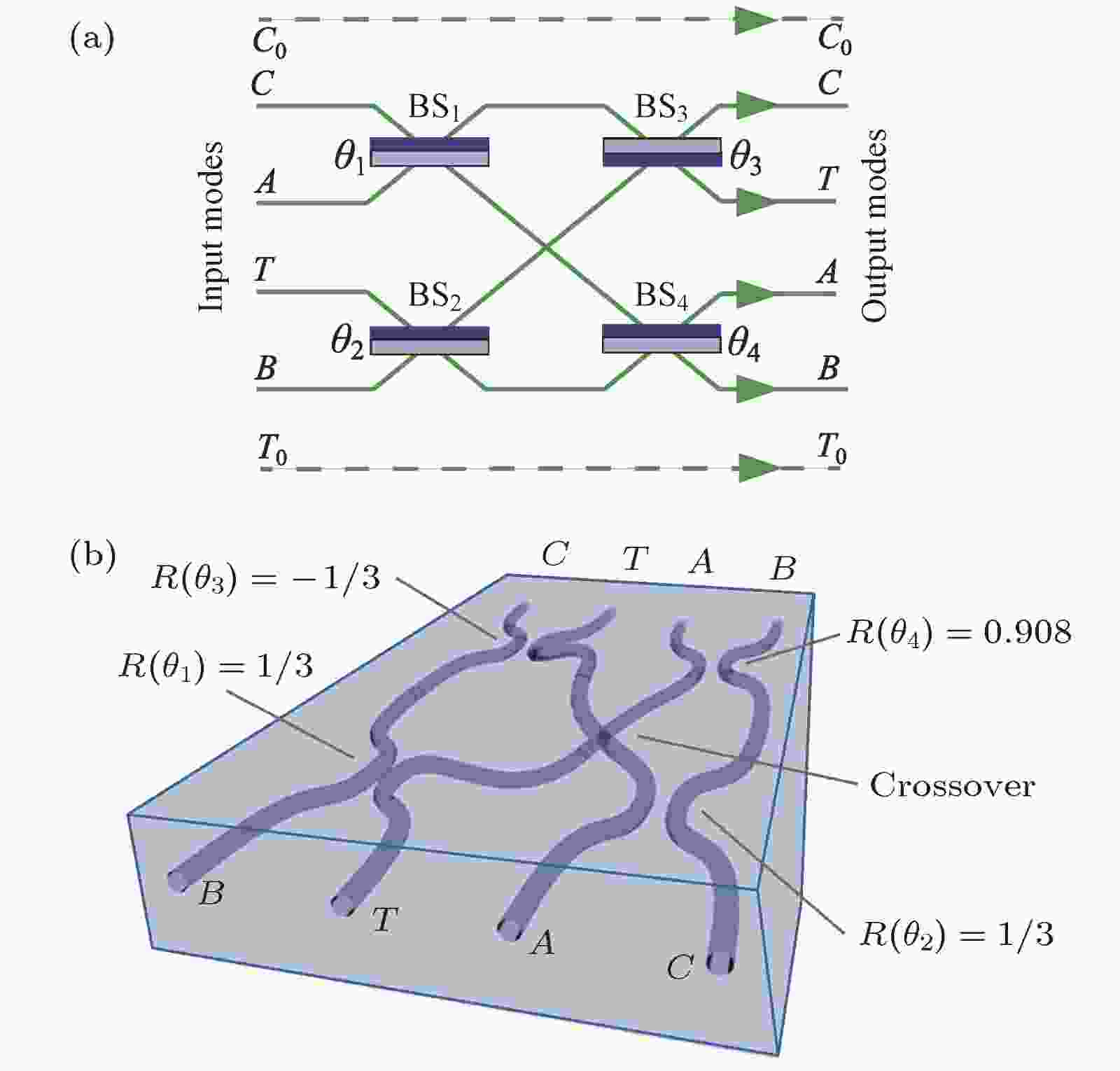 图 15 路径编码的hCZ门结构图[69] (a)路径C0 (T0)代表|0〉态, 不与其他态相互作用, C (T)代表|1〉态, A和B代表辅助光子态, 它们通过四个定向耦合器相互作用, 耦合器反射率R(θn) =??cos2(θn), 图中浅色面代表附加
图 15 路径编码的hCZ门结构图[69] (a)路径C0 (T0)代表|0〉态, 不与其他态相互作用, C (T)代表|1〉态, A和B代表辅助光子态, 它们通过四个定向耦合器相互作用, 耦合器反射率R(θn) =??cos2(θn), 图中浅色面代表附加
Figure15. Schematic of a path-encoded qubit hCZ gate[69]. (a) The circuit for a hCZ gate showing paths for ancillary photons A and B as well as the computational qubits; the control (target) photon is encoded across spatial paths C0 (T0) representing |0〉 and C (T) representing |1〉. The |0〉 modes do not interact in the gate; the four remaining modes undergo four DCs operations with reflectivities R(θn) =??cos2(θn). The light-coloured side indicates the surface yielding a relative

我们课题组利用飞秒激光首次在EAGLE2000玻璃中加工出了路径编码量子比特的CNOT门[70], 结构分布同图12所示, 不同之处在于光子无论经历耦合器上表面反射还是下表面反射都会获得一个




























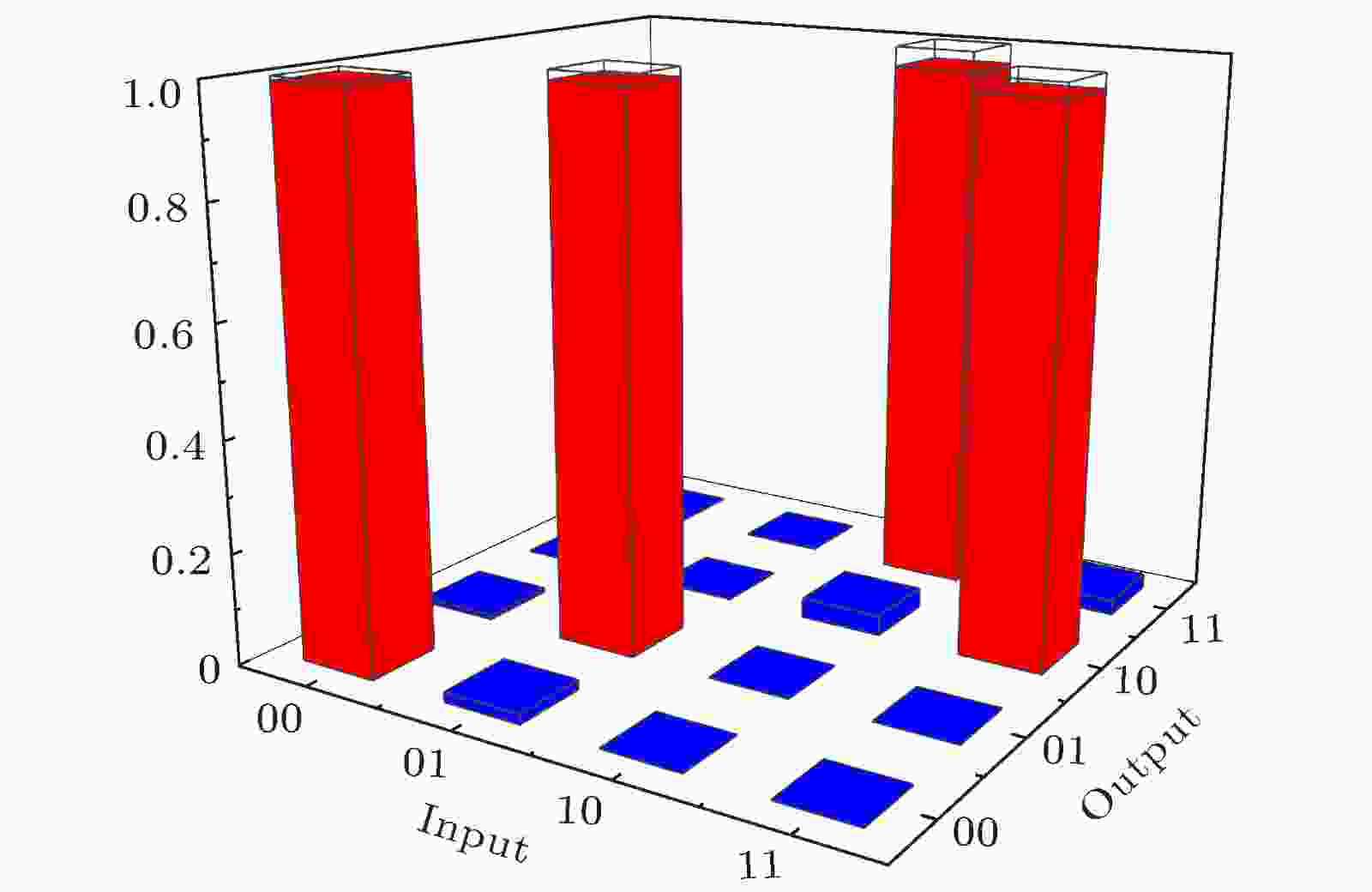 图 16 根据实验实测值构建的真值表柱状图, 保真度约为0.98
图 16 根据实验实测值构建的真值表柱状图, 保真度约为0.98Figure16. Experimentally constructed CNOT logical truth table. The labels on the Input and Output axes identify the state |C, T〉. Ideally, a flip of the logical state of the target qubit (T) occurs only when the control qubit (C) is in the logical |1〉 state. The fidelity of the gate is ~ 0.98.



































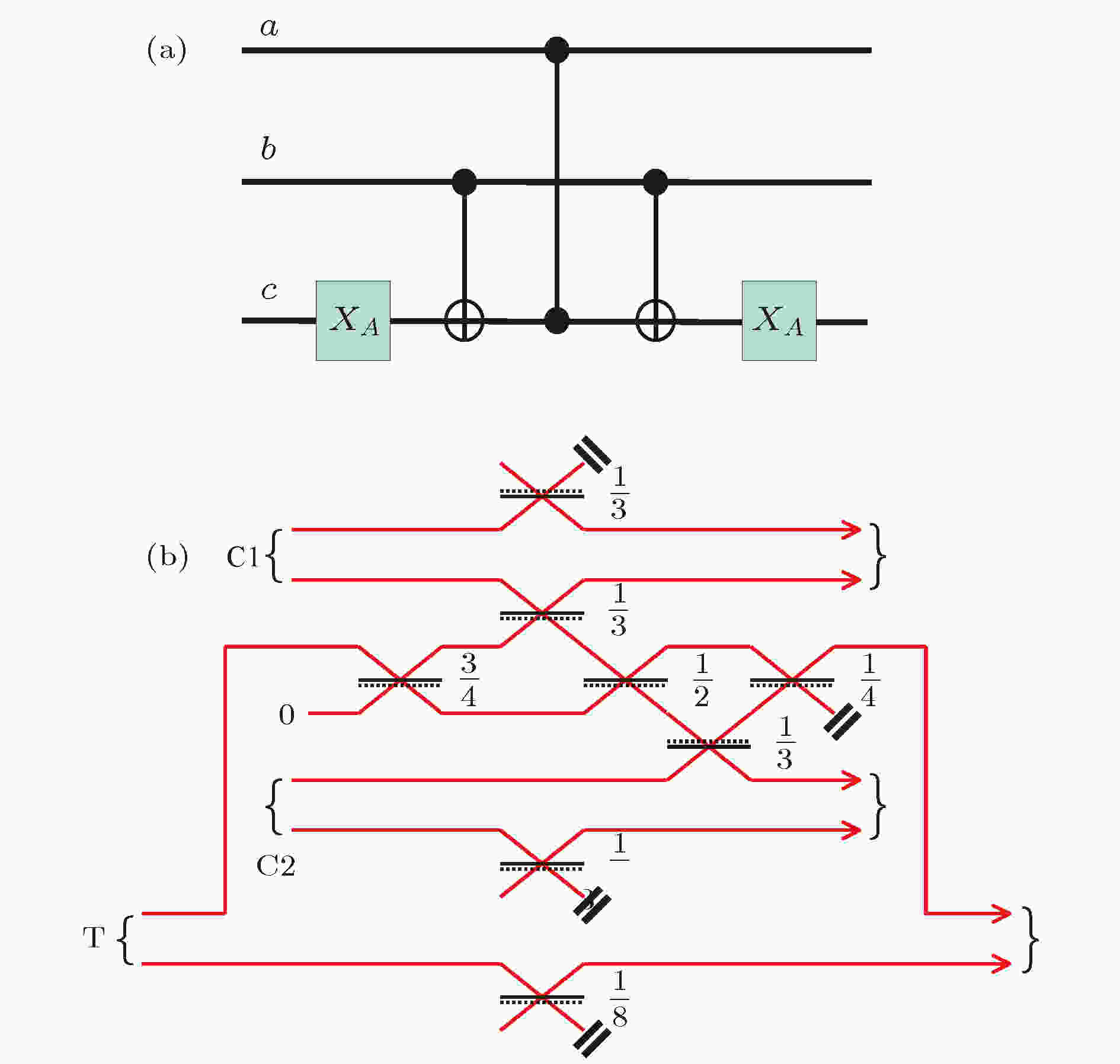 图 17 控制比特(a, b)为qubit、目标比特(c)为qutrit(
图 17 控制比特(a, b)为qubit、目标比特(c)为qutrit(


Figure17. (a) Realization of aToffoli gate using two qubits (a and b) and a qutrit (c). CNOT gates (first andlast two-qubit gates) operate as normal on the qubit levels andimplement the identity if the target is in the qutrit level (|2〉). Similarly for the CZ gate (middle two-qubit gate). The XA gate flips thequtrit between the states |0〉 and |2〉. The sign change occurs on the|1,0,1〉 component. (b) A nondeterministic, post-selected, opticalrealization of a Toffoli gate[79]. Each input qubit is represented bytwo modes (waveguide paths). An additional target mode is introduced in the central part of the diagram. DCs are represented as black lines with their reflectivity indicated to the right. A phase flip occurs by reflection off the surface indicated by a dotted line. If we take occupation of the top mode of each qubit to represent logical |0〉 and occupation of the bottom mode to represent logical |1〉, then the circuit implements a Toffoli gate in which a phase flip is only applied to the element |000〉.
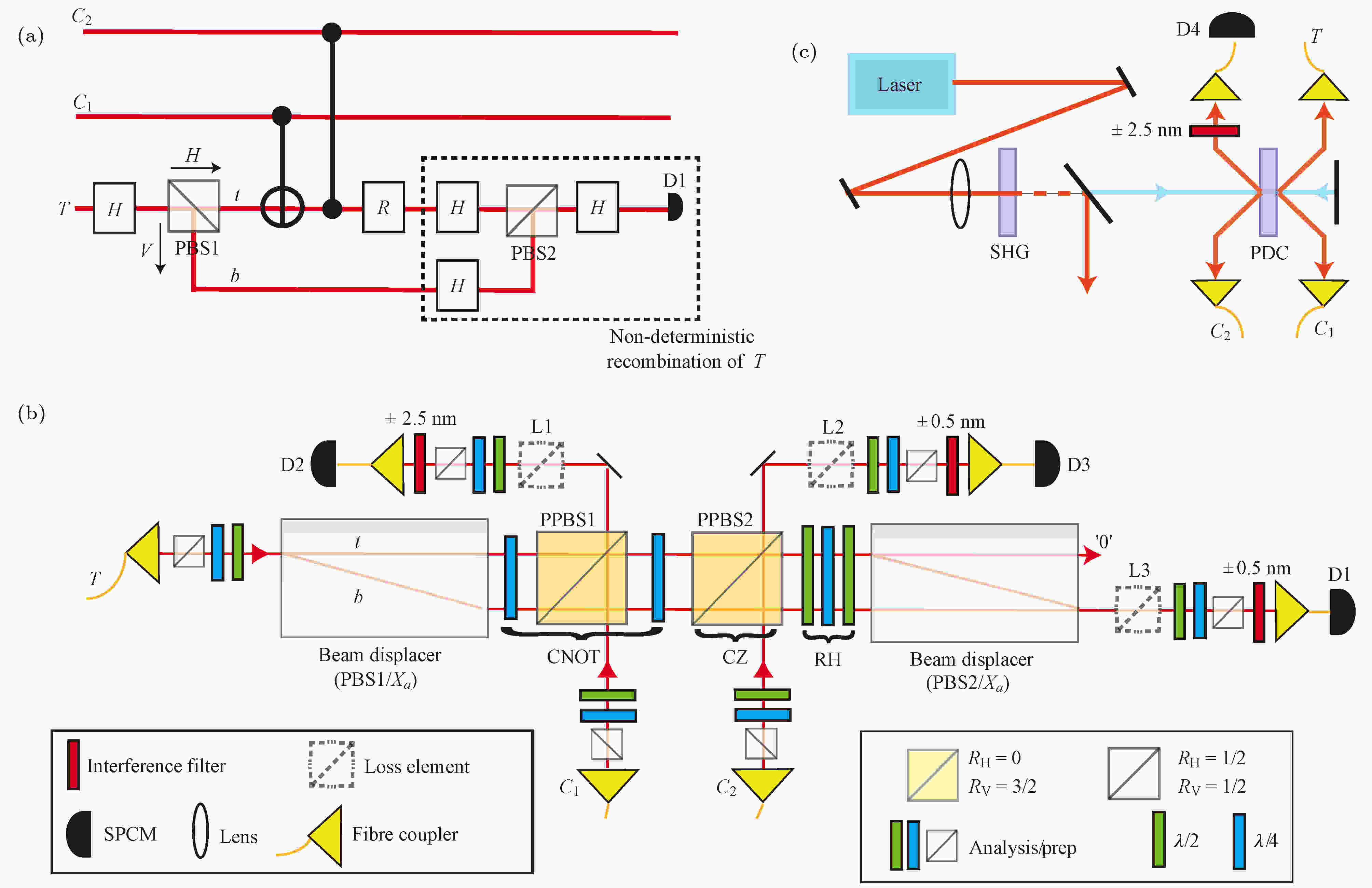 图 18 利用体光学元件在自由空间中实现Toffoli门的实验装置[80] (a)逻辑线路图, 采用|H〉偏振和|V〉偏振编码量子比特的|0〉态和|1〉态两个状态, 通过偏振分束器PBS1扩展出一条额外的路径b, 从而将目标比特从两态系统扩展到四态系统, 即|H, t〉, |H, b〉, |V, t〉和|V, b〉四种状态, 下路径b绕过了后面两个两比特逻辑门; 当在探测器D1上探测到一个光子时, Toffoli门操作成功; (b), (c)实验装置; PPBS, 部分偏振分束器; SPCM, 单光子计数模块; PDC, 参量下转换; SHG, 二次谐波产生
图 18 利用体光学元件在自由空间中实现Toffoli门的实验装置[80] (a)逻辑线路图, 采用|H〉偏振和|V〉偏振编码量子比特的|0〉态和|1〉态两个状态, 通过偏振分束器PBS1扩展出一条额外的路径b, 从而将目标比特从两态系统扩展到四态系统, 即|H, t〉, |H, b〉, |V, t〉和|V, b〉四种状态, 下路径b绕过了后面两个两比特逻辑门; 当在探测器D1上探测到一个光子时, Toffoli门操作成功; (b), (c)实验装置; PPBS, 部分偏振分束器; SPCM, 单光子计数模块; PDC, 参量下转换; SHG, 二次谐波产生Figure18. Toffoli and controlled-unitary experimental layout[80]. (a) Conceptual logic circuit. A polarizing beam splitter temporarily expands the Hilbert space of the target information carrier, from a polarization-encoded photonic qubit to a multi-level system distributed across polarization and longitudinal spatial mode. Information in the bottom rail (b) bypasses the two-qubit gates. Detection of a photon at D1 heralds a successful implementation; (b), (c) Experimental circuit and optical source. An inherently stable polarization interferometer using two calcite beam displacers is used. PPBS, partially polarizing beam splitter; SPCM, single-photon counting module; PDC, parametric down conversion; SHG, second-harmonic generation.
另外一种通用的三量子比特逻辑门是Fredkin门, 也即受控SWAP门, 与Toffoli门明显的不同之处在于它只包含一个控制比特, 但有两个目标比特, 当且仅当控制比特处于|1〉态时, 两个目标比特相互交换所处的态[81-84], 其门操作的本征态是纠缠的对称或非对称目标比特态, 而Toffoli门操作的本征态是分立态, 因此Fredkin门可直接应用于许多量子信息协议, 比如纠错[72]、指纹识别[85]、最优克隆[86]和受控纠缠筛选等. 2008年, Fiurá?ek等在他们之前提出的偏振编码的部分SWAP门[87,88]基础上改进, 利用两个CNOT门构成的相位门替代经典的相移器, 由控制比特态决定相位门的相位变化, 实现了自由空间的Fredkin门, 如图19(a)所示, 通过入射到两个CNOT门的两个光子态来编码控制比特输入态, 使其从非纠缠的



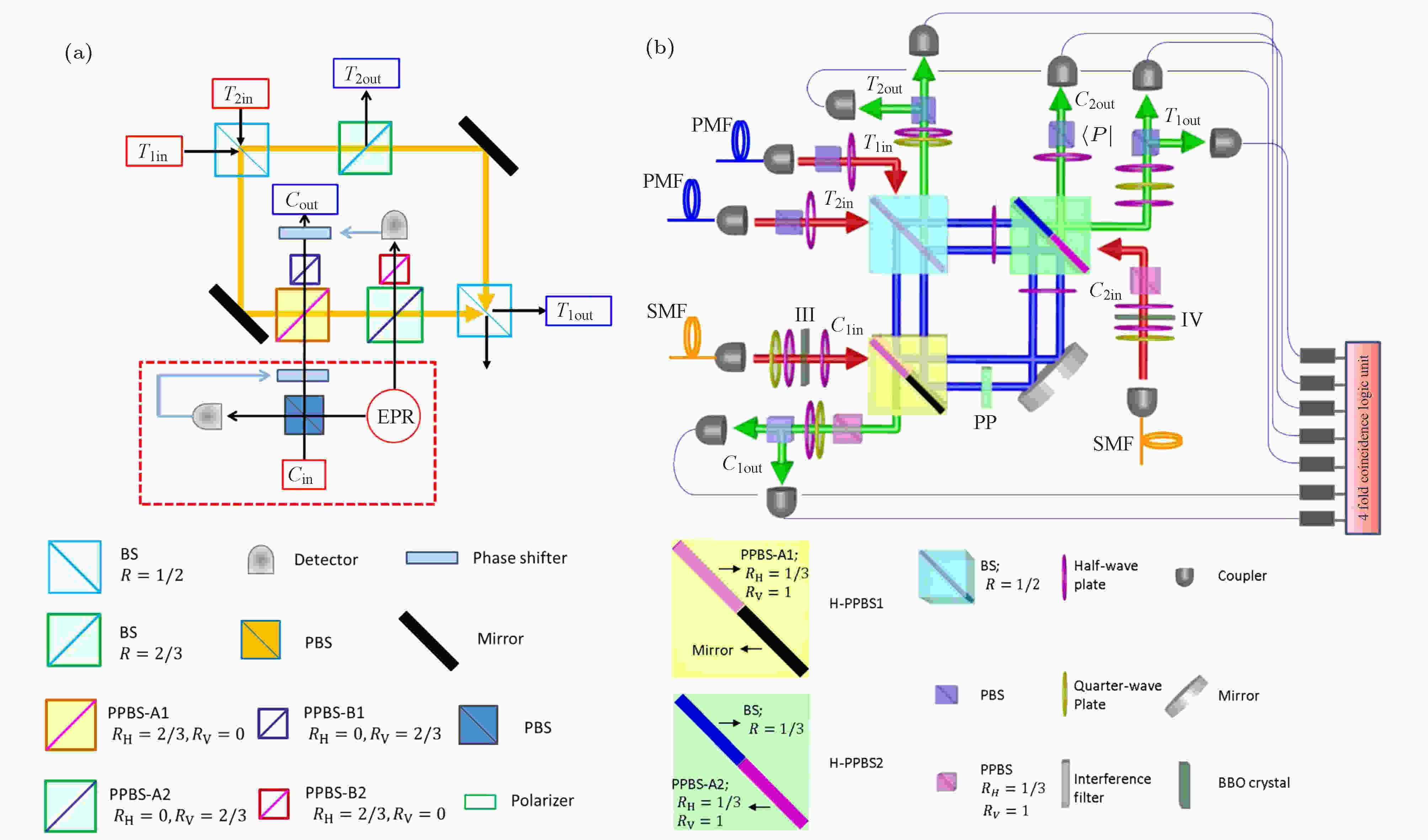 图 19 利用体光学元件在自由空间中实现Fredkin门的两种实验方案 (a)早期实验方案, 控制比特态决定相位门的相位变化, 该相位门两个CNOT门构成, CNOT操作基于部分偏振分束器上的双光子干涉实现, 入射到两个CNOT门的两光子态编码控制比特输入态, 使其从非纠缠的
图 19 利用体光学元件在自由空间中实现Fredkin门的两种实验方案 (a)早期实验方案, 控制比特态决定相位门的相位变化, 该相位门两个CNOT门构成, CNOT操作基于部分偏振分束器上的双光子干涉实现, 入射到两个CNOT门的两光子态编码控制比特输入态, 使其从非纠缠的




Figure19. Two kinds of free-space experimental layouts for Fredkin gate. (a) Original proposal by Fiurá?ek. The phase of the quantum phase gate (QPG) is changed by a control qubit: φ = 0 (






如果仅用一种编码方式(比如路径编码或偏振编码)实现飞秒激光直写Toffoli门, 所需要的两量子比特门和单量子比特门数量众多, 涉及到大量不同分束比的定向耦合器和不同相位关系的MZ干涉仪, 同时精确控制各分束比和波导相位异常困难, 且多光子输入对损耗要求非常高, 需要将现有波导损耗降低至少一个数量级. 如果利用多重自由度对光子进行高维编码, 那将会涉及到立体交叉的真三维波导构架, 同时调控路径、偏振、模式等也对加工工艺提出了前所未有的挑战. 我们正在尝试利用飞秒激光直写技术制备三比特量子逻辑门.
感谢意大利米兰理工大学R. Osellame教授及其组内F. Pellegatta等研究生对我们飞秒激光直写CNOT门实验的指导与帮助, 感谢中国科学技术大学任希锋副教授及其组内陈阳等研究生对我们量子光源的搭建及量子测试实验的指导与帮助.
